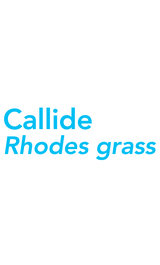Download a copy of the Callide Rhodes Grass factsheet.
Native to Africa
Burundi, Democratic Republic of Congo (Zaire), Ethiopia, Kenya, Mali, Mozambique, Niger, Senegal, Sierra Leone, Somalia, South Africa, Sudan, Tanzania, Uganda, Zimbabwe.
Callide can be used as permanent pasture or as a short- to medium-term pasture ley to restore soil structure, improve organic matter levels and reduce nematode numbers. Can also be under sown into maize. Makes good hay if cut at or just before very early flowering (although Katambora is generally considered to produce the best quality hay). Generally not suitable for silage. Provides fair standover roughage when mature, better than Cenchrus ciliaris and Panicum maximum due to its greater cold resistance and lower loss of dry leaves. Develops good ground cover and effectively controls erosion once established (needs regular defoliation to maintain cover). Also effectively suppresses woody weed regrowth provided trees and shrubs are not well established prior to planting the grass.
Found in open woodland and grassland, riverine and lake margins, and seasonally waterlogged plains, on a wide range of soils. Recovers well after fire.
Key features
- Highly palatable, very late flowering and productive stoloniferous grass
- Well suited to companion legumes such as Siratro and B1 Burgundy
- Ideal for quality grazing and/or hay making
Establishment
Seed of the diploids (Katambora) has little or no post-harvest dormancy, while seed of the tetraploids (Callide) may not reach maximum germination for 3–6 months (sometimes up to 18 months) after harvest. Seed is best sown on the surface (definitely no deeper than 1 cm) of a well-prepared seedbed, followed by rolling. The fluffy seed tends to “ball” or bridge when planting, therefore the use of AgriCOTE Pro-Tech seed is recommended for all planting applications (broadcasting, seed drills). Seed germinates in 1–7 days and seedlings develop rapidly.
Agronomy and management
Stands develop quickly and can be grazed 4–6 months after planting, although highest production is reached in the second year. Growth commences early in spring. Since feeding value declines rapidly with onset of flowering, it is important to maintain the stand in a leafy condition by fairly regular defoliation.
Performance
Callide rhodes grass forms strong bunch-type stools; its runners rapidly cover the ground surface, anchoring at the nodes and producing plantlets. Its vigorous root system gives a degree of drought resistance but it performs best in the 700 – l,000 mm belt. Callide shows moderate frost tolerance, but is primarily a summer grower. It is quite versatile in its soil requirements, although it grows best on softwood scrub red loams and the stronger brigalow soils. Callide is quite salt tolerant (however not as good as Katambora), and is one of the best grasses for sowing on earthworks. Callide will combine with B1 Burgundy, Siratro, Stylo, Lotononis and Wynn cassia in coastal/sub-coastal areas of higher rainfall and with alfalfa in inland districts. Crude protein levels vary with age of regrowth and level of available soil nitrogen, from about 17% (on a DM basis) in very young leaf, to 3% in old leaves. Similarly, digestibility may vary from 80% in very young growth to 40% in older growth.
Animal production
Callide can carry about 1 – 4 beasts/ha depending on pasture productivity and size of animal. Annual live weight gains of up to 170kg/head are achievable. Production levels decline without a vigorous legume or the use of fertiliser nitrogen.
Toxicity
No record of toxicity. Levels of oxalate in the DM are low, making this an ideal species for horse pastures, although there are some suspicions that it may cause skin troubles. If indeed it does, this is not a common problem.
Pest / disease resistance
Severe attack by armyworm and pasture webworm can destroy much of the leaf, particularly young leaf - largely restricted to coastal areas. No serious diseases.
Suggested sowing rates
Recommended planting rates for AgriCOTE Pro-Tech for Callide rhodes grass are:
Marginal dryland: 5 – 7kg per hectare
Good dryland: 8 – 12kg per hectare
Irrigated: 15 – 20kg per hectare
Disclaimer: The information presented in this brochure is from official and other sources and is considered to be reliable. It is provided in good faith and every care has been taken to ensure its accuracy. Barenbrug does not accept any responsibility for the consequences that may arise from the acceptance of recommendations or the suggestions made.



